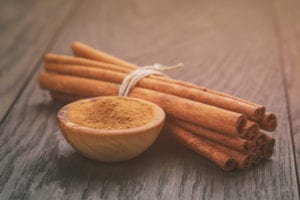Written by Taylor Woosley, Staff Writer. Findings from the systematic review and meta-analysis of 14 RCTs with 965 participants shows that cinnamon supplementation significantly reduced TG (p = 0.005) and LDL-C levels (p = 0.004), while improving HDL-C levels (p < 0.001).
 Diabetes mellitus is a metabolic disorder caused by chronic high glucose levels in the blood because of the incapability of beta cells in the pancreas to produce adequate insulin or ineffective insulin utilization by cells in the body1. The number of diabetes patients worldwide may rise to about 370 million in 2030 from about 170 million in 2000, with around 90% of those cases being type 2 diabetes mellitus (T2DM)2. T2DM is characterized by insulin resistance and hyperglycemia, which is usually accompanied by abnormal lipid metabolism3.
Diabetes mellitus is a metabolic disorder caused by chronic high glucose levels in the blood because of the incapability of beta cells in the pancreas to produce adequate insulin or ineffective insulin utilization by cells in the body1. The number of diabetes patients worldwide may rise to about 370 million in 2030 from about 170 million in 2000, with around 90% of those cases being type 2 diabetes mellitus (T2DM)2. T2DM is characterized by insulin resistance and hyperglycemia, which is usually accompanied by abnormal lipid metabolism3.
Cinnamon is popular as a dietary component and traditional herbal medicine due to its hypoglycemic, lipid-lowering, and antioxidant properties4. It contains cinnamaldehyde, a water-soluble polyphenol that possesses anti-inflammatory properties through regulation of IL-1 and IL-6, C-reactive protein, and tumor necrosis factor (TNF) alpha level5. Furthermore, cinnamaldehyde may enhance insulin sensitivity by inhibiting the enzyme protein tyrosine phosphatase 1B, which inactivates insulin receptors and increases the glucose-transporting molecules required for glucose uptake by adipose and muscle cells from plasma6.
Yu et al. conducted a systematic review and meta-analysis of randomized controlled trials (RCTs) to analyze the effect of cinnamon on glucolipid metabolic indexes in subjects with T2DM, while also analyzing the dose-response relationships. Study inclusion consisted of following an RCT design focused on cinnamon intervention, with subjects not using insulin during the trial, with the following outcome variables included in the study: HbA1c, fasting blood glucose (FBG), total cholesterol (TC), high-density lipoprotein cholesterol (HDL-C), low-density lipoprotein cholesterol (LDL-C), and triglycerides (TG).
14 RCTs were included in the final analysis. The 14 studies involved 965 participants with a mean age of 52.1 to 64.6 years. Study duration of cinnamon intervention ranged from 6 weeks to 16 weeks and doses ranged from 120 mg/d to 3000 mg/d. Fractional polynomial models were used to assess the quantitative-effect relationships of cinnamon intervention dose and intervention durations in relation to intervention effects in a nonlinear dose-response analysis. Significant findings of the systematic review and meta-analysis are as follows:
- 9 studies with available TG data reports that cinnamon intervention significantly reduced TG levels (mean difference=-7.31; 95% CI: -12.37, -2.25, p = 0.005, I2 = 40.2%). A significant non-linear relationship between the dose of cinnamon and TG levels was noted (p-nonlinearity = 0.016).
- 10 studies with measured HDL-C levels shows that cinnamon significantly increased HDL-C levels (mean difference=1.53 95% CI: 1.01, 2.05, p < 0.001, I2 = 44.0%).
- 7 studies with LDL-C measurements show results that indicate a significant effect of cinnamon on LDL-C concentration (mean difference=-6.78; 95% CI: -11.35, -2.22, p = 0.004, I2 = 2.7%). A non-linear correlation was observed between cinnamon dose and LDL-C levels (p=nonlinearity = 0.019).
- Sub-group analysis shows that cinnamon intervention ≤1200 mg/d significantly reduced FBG levels (mean difference = -11.1; 95% CI -14.64, -7.58, p < 0.001).
Results of the systematic review and meta-analysis shows that cinnamon supplementation significantly lowered LDL-C and TG levels, while increasing HDL-C levels. Furthermore, a non-linear dose-response was observed between cinnamon and TG and LDL-C. Further research should continue to explore the effects of varying dosages of cinnamon and its potential effects on glucose and lipid levels.
Source: Yu, Tingqing, Kun Lu, Xinyi Cao, Hui Xia, Shaokang Wang, Guiju Sun, Liang Chen, and Wang Liao. “The Effect of Cinnamon on Glycolipid Metabolism: A Dose–Response Meta-Analysis of Randomized Controlled Trials.” Nutrients 15, no. 13 (2023): 2983.
© 2023 by the authors. Licensee MDPI, Basel, Switzerland. This article is an open access article distributed under the terms and conditions of the Creative Commons Attribution (CC BY) license (https://creativecommons.org/licenses/by/4.0/).
Click here to read the full text study.
Posted August 8, 2023.
Taylor Woosley studied biology at Purdue University before becoming a 2016 graduate of Columbia College Chicago with a major in Writing. She currently resides in Glen Ellyn, IL.
References:
- Berbudi A, Rahmadika N, Tjahjadi AI, Ruslami R. Type 2 Diabetes and its Impact on the Immune System. Curr Diabetes Rev. 2020;16(5):442-449. doi:10.2174/1573399815666191024085838
- Jing X, Chen J, Dong Y, et al. Related factors of quality of life of type 2 diabetes patients: a systematic review and meta-analysis. Health Qual Life Outcomes. Sep 19 2018;16(1):189. doi:10.1186/s12955-018-1021-9
- Ma CX, Ma XN, Guan CH, Li YD, Mauricio D, Fu SB. Cardiovascular disease in type 2 diabetes mellitus: progress toward personalized management. Cardiovasc Diabetol. May 14 2022;21(1):74. doi:10.1186/s12933-022-01516-6
- Zarezadeh M, Musazadeh V, Foroumandi E, Keramati M, Ostadrahimi A, Mekary RA. The effect of cinnamon supplementation on glycemic control in patients with type 2 diabetes or with polycystic ovary syndrome: an umbrella meta-analysis on interventional meta-analyses. Diabetology & metabolic syndrome. Jun 15 2023;15(1):127. doi:10.1186/s13098-023-01057-2
- Silva ML, Bernardo MA, Singh J, de Mesquita MF. Cinnamon as a Complementary Therapeutic Approach for Dysglycemia and Dyslipidemia Control in Type 2 Diabetes Mellitus and Its Molecular Mechanism of Action: A Review. Nutrients. Jul 5 2022;14(13)doi:10.3390/nu14132773
- Mandal A, Sharma S, Rani R, Ranjan S, Kant R, Mirza A. Impact of Cassia Bark Consumption on Glucose and Lipid Control in Type 2 Diabetes: An Updated Systematic Review and Meta-Analysis. Cureus. Jul 2021;13(7):e16376. doi:10.7759/cureus.16376
